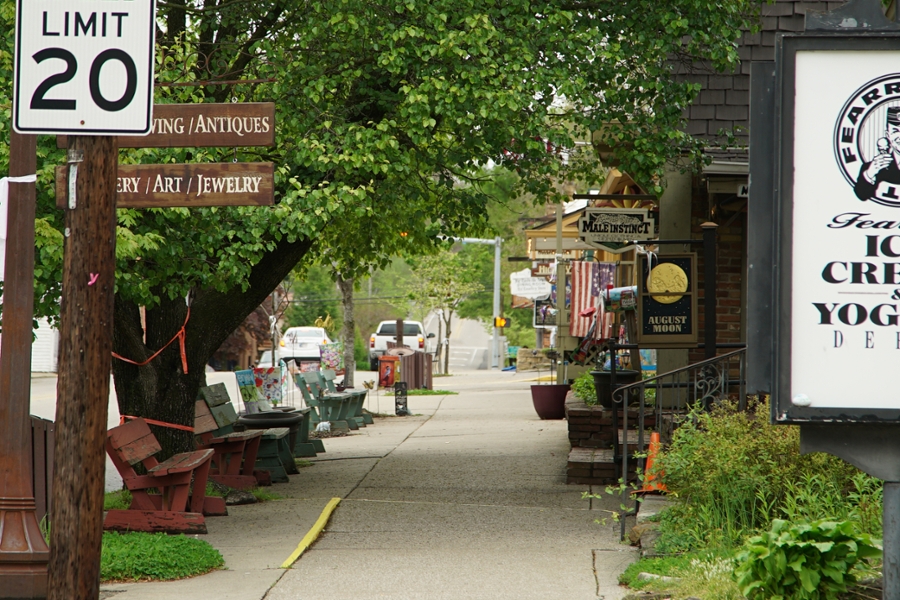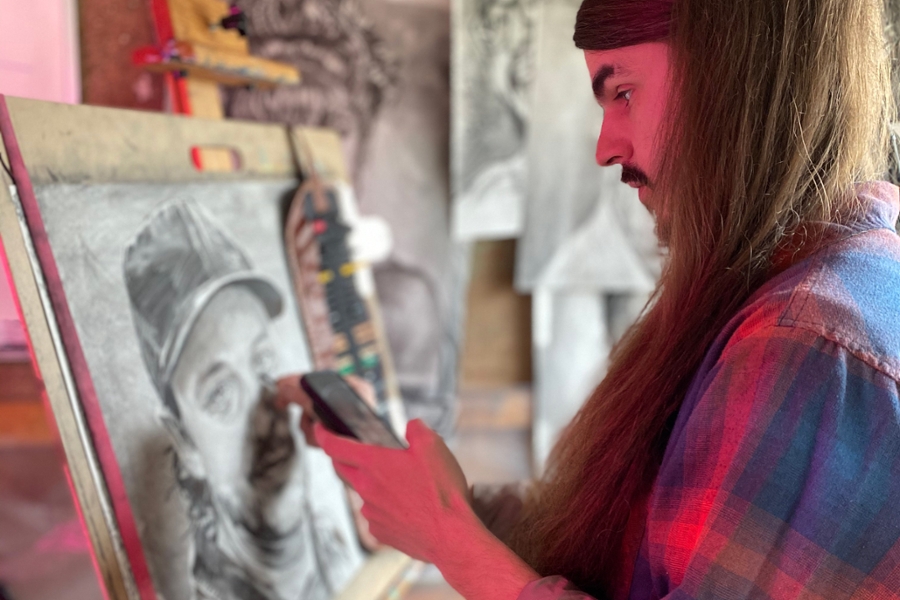Take a slice of a few decades out of any place and you’re bound to get some wild stories. WTIU's no different; but even before the station was operating as a broadcaster, its halls were full of those tall tales.
Barrie Zimmerman, who acted as WTIU’s production manager from 1972 until 1989 and then director of operations and engineering until he retired in 2005, has been working to collect those stories in an oral history of the station.
The following - written with Dennis James - is an excerpt on the infamous studio organ, which was housed in the TV studio just before WTIU was in operation. Take a look below. And for more stories about WTIU through the years, head to the anniversary site.
The Pipe Organ
By Barrie Zimmerman and Dennis James
The Chair of the Radio & Television Department, Elmer Sulzer (1954-1964), had a number of interests and talents. Among them, music - he was a musician-entertainer and those talents were at a keyboard. Stories told said that, during his college days, he earned extra money by “cutting” player piano rolls. Indeed, Elmer was an accomplished keyboard artist and organist of the popular music genre, and his favorite instrument was a theater pipe organ.
Presumably, sometime in the 1950s, after negotiations with the owner of the Princess Theatre in downtown Bloomington, Elmer was able to acquire, on behalf of the Radio & Television Department, the Estey theater pipe organ that had been in that theater. The console was a two-manual model with a full pedalboard. A good sampling of typical theater organ effects were included – drum, block, train whistle, cymbals, xylophone, etc. When first acquired, this pipe organ was installed in Studio B in the original barracks building.
 A photo of the Estey organ at the Princess Theatre in downtown Bloomington. (Photo: Steven Fink)
A photo of the Estey organ at the Princess Theatre in downtown Bloomington. (Photo: Steven Fink)
Stories also told said that Elmer often would provide noontime entertainment with the studio doors opened to the hallway. It is thought that a number of musical TV programs were produced in Studio B and may have featured “The Faculty Five” instrumental ensemble, along with other performers. The pipe organ undoubtedly was included in some of these programs.
Some in the building did not necessarily appreciate the organ concerts, presumably because the organ may not have been in good condition and the old building had little soundproofing. One story is that one day, during one of Elmer’s sessions, someone walked into the studio and fired a starter’s pistol. Supposedly, that ended the random concerts.
As noted in other sections of this historical account, the plans for the current Radio-TV Building were titled “Hall of Music Annex #2.” One might expect that it was appropriate to have some musical instruments. Consequently, TV Studio 5 was designed with an organ chamber and organ blower room, specifically to accommodate the Estey theater organ. The organ chamber was located on the north wall of the studio and had a tasteful wooden façade with acoustic fabric to conceal the pipes and swell shades. The organ blower room was adjacent to the organ chamber and was accessible via a small door from the Scene Shop. The move and refurbishing of the pipe organ was included as part of the construction of the building.
This work was done by the John Cave Organ Company of Evansville, IN. That work included a new wind chest, repair work on pipes, refurbishing of the console and the installation of a new manual switching mechanism to provide far greater flexibility in the selection of “combinations” from the manuals, or keyboards.
The Cave Organ Co. removed the organ from the barracks building and completed the shop work in Evansville. In approximately late 1964 or early 1965, the refurbished instrument was installed in Studio 5. Following that, there were occasional noon-hour concerts, for nearly an hour, when classes or labs were not in session. Elmer was in his element and provided great entertainment, often joined by faculty member Martha Walstrum on vocals, and others who appreciated the opportunity to sing along.
In 1967, a student of Oswald Ragatz, Jacobs School of Music Organ Department Chair and Professor, had learned of this organ and spoken with Bill Kroll with the idea of showing silent films and using the Studio 5 organ as accompaniment, much the same as would have been done in the days of silent movies. Bill Kroll was in an ideal position to handle this request – he had a strong photography-film background, taught a class in film for television, and was the most knowledgeable of the Radio-TV faculty in terms of film genre. And, as Director of Operations for the Radio-TV Department, he also understood what would be involved. Studio 5 also was an ideal setting for this event, since its floor plan was similar to a theater, minus a projection booth.
Subsequently, the first campus showing of a silent movie with organ accompaniment was held in Studio 5. That concert showing was the first of a long-standing series of Halloween silent film concerts, now a popular Bloomington campus tradition. The student-organist was IU graduate Dennis James, who became perhaps the most accomplished and best-known theater organist and authority on the silent film-organ genre. A year after the concerts began in Studio 5, they were moved to the IU Auditorium, where the Halloween concerts have continued to this day, with Dennis James at the console. October 2018 marked the 50th year of this popular and unique campus tradition.
Elmer Sulzer passed away in the late 1960’s and the organ was no longer used. The console was on a large roll-around dolly with a large, cumbersome wiring harness. This took a lot of space that was deemed more important for TV production and labs. Consequently, around 1970, or so, the organ was auctioned and removed from the premises. There are no remaining parts or traces of the organ. The upper part of the organ chamber was converted, with a new floor, to expand the Television Master Control space in order to accommodate more technical equipment. The lower part was used for studio storage and, in the 1996-1998 renovation project was rearranged for a more workable space. The organ blower room became a secure tool storage room for the Scene Shop.
The following stories were written by Dennis James.
Rumor has it Hoagy Carmichael played this Princess Theatre Estey Organ accompanying silent films during his student days at IU.
One night, I was working alone in the organ chamber and got myself trapped behind one of the percussion assemblies: the chime rack was set against a wall in the organ chamber and I had barely enough room to squeeze in behind, and there were many protruding organ parts, pins of wire, and many things that snagged my clothes and dug into my skin. Anyway, at one given point I noticed I couldn’t go forward nor backward, couldn’t turnaround, couldn’t reach for anything, nor go up or down because doing any of those things would cause great pain from being poked and stabbed by the organ parts. So, I was trapped and spent the night in that position until somebody came into the organ room the next morning and helped me get away.
At one point we were adding switches to the horseshoe shaped organ controller areas, and were about to install a small vertical switch, but didn’t actually have the switch in hand. So we stopped work that day leaving a cut in the wooden surround. I had a bright idea, put a piece of masking tape over the hole, cut a nice slot opening and wrote the instructions INSERT 25 CENTS. And sure enough, when we came back after that weekend there were about 6 quarters inside the console. People had inserted their quarters into the hole, and, of course, there wasn’t any mechanism behind and nothing at all happened.
For our first silent film show at the IU Radio Station, I wanted a bomb effect sound to happen when the robbers blew up a strong box in the mail car of a train while it was running down the tracks in the 1903 Thomas Edison silent film The Great Train Robbery. One of our organ workers had the bright idea to rig up a .38 caliber pistol fastened to the side of the Chimes rack assembly. He added a washing machine solenoid to be able to pull the trigger by the push of a button on the organ console. Then he loaded the revolver to fire blanks, aiming directly at a wall and had taken the safety step to mount a metal plate onto the wall where the blast effects coming from the pistol would be most concentrated. We didn’t have any time to test it and he told me it would work, so along I went into the film show, coming to the robbery scene, and watching the robbers set the fuse on the bomb.
I hit the “explode” button at just the right time - - unfortunately, the room the organ spoke into was small, seating maybe 50 people when appearing full, and the pistol explosion coming out of the chamber sounded akin to an atomic blast to the audience causing people to shriek and howl in fright, with many spontaneously standing up. The power of the blast knocked the chimes tubes from their mounts and they went cascading to the organ chamber floor clattering to a heap. Most impressive of all: the smoke from the blank charge poured out of the organ grill and into the audience causing the film image to be projected onto smoke instead of the obscured screen. It rippled about illegibly until the smoke faded away.
Our crew leader decided to figure a way to get working tremulants into the wind system of the instrument, coming up with the idea of creating a dump valve and exhausting compressed air from various sources in the organ design to a regular pulse of six and a half movements of the tremulant device per second (creating a similar shaking sound to the pipes in order to be comparable to that of a soprano singer performing in the traditional operatic manner).
Pictured in the attached images is the very first hand-printed ticket I made in the IMU student craft shop, and mention of the beginnings of silent film screenings at IU with the Organ Journal article about the Estey Organ written from the perspective of a person who attended a special organ concert, without film, for visiting theatre organ buffs who were brought by bus from Indianapolis.
For more stories on WTIU from Barrie Zimmerman, check out the WTIU50 site.




